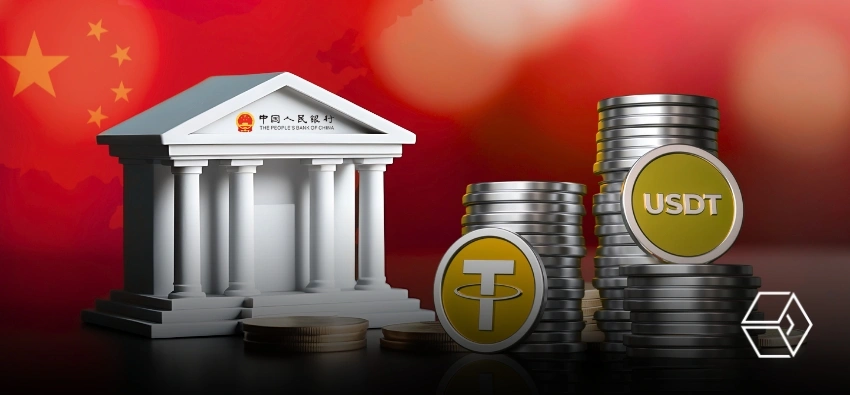
- China says stablecoins threaten global finance and weaken monetary sovereignty.
- Global regulators warn of stablecoin loopholes in AML and capital control systems.
- PBOC promotes e-CNY to ensure financial stability and limit foreign currency dominance.
China’s central bank has issued one of its strongest warnings yet on the rise of stablecoins, stating that they could erode global financial stability if left unregulated. At the 2025 Financial Street Annual Meeting in Beijing, Pan Gongsheng, Governor of the People’s Bank of China (PBOC), said privately issued tokens such as USDT and USDC pose “serious loopholes” in the current monetary framework.
Pan explained that these dollar-pegged assets might enable unmonitored cross-border fund transfers, erode capital controls, and circumvent anti-money laundering standards. He added that the growth of foreign-denominated tokens could limit a country’s ability to control money supply and interest rates.
China’s Central Bank Warns Stablecoins Risk Global Stability (Source X)
Historically, China has banned crypto trading and mining since 2017, but its regulators remain alert. The country continues to tighten oversight of offshore platforms and has maintained that privately issued stablecoins could disrupt its long-term plan for monetary security.
Global Regulators Share Similar Concerns
Pan’s remarks follow broader global discussions on stablecoin risks. During the IMF and World Bank Annual Meetings in Washington, D.C., financial leaders from across the world identified the unchecked spread of stablecoins as a potential challenge to monetary sovereignty. They noted that most issuers have yet to fully comply with customer identification and AML protocols, raising concerns about illicit fund movements.
According to Pan, these gaps create “pathways for speculation, money laundering, and financial instability.” He warned that without strong international oversight, stablecoins could amplify shocks in developing markets already facing currency pressure.
On the other hand, the stablecoin market has ballooned to over $160 billion, dominated by Tether and Circle. Their tokens now serve as essential tools for trading, remittances, and DeFi liquidity, often functioning as unofficial alternatives to national currencies in regions with weaker banking systems.
China’s Digital Yuan and Policy Direction
While Beijing continues to reject privately issued stablecoins, it has been promoting its own state-backed alternative, the digital yuan (e-CNY). Designed as legal tender, the e-CNY allows digital transactions without sacrificing government control over monetary policy.
Pan said the goal is to combine efficiency with oversight. “Technology can modernize finance,” he noted, “but it must never weaken national authority.”
As a result, authorities have kept a close eye on domestic tech firms that have shown interest in blockchain-based payments. The PBOC has been coordinating with law enforcement agencies to clamp down on illegal digital asset trading while monitoring offshore markets that interact with Chinese users.
Different Paths to Regulation
Other financial centers have taken less restrictive approaches. In the United States, lawmakers are finalizing the Stablecoin Regulation Act, which would bring issuers under federal supervision while allowing innovation within defined boundaries.
The European Union has already rolled out its MiCA framework, classifying stablecoins as “asset-referenced tokens” and placing them under the European Banking Authority. Moreover, Singapore and Hong Kong have opted for blended systems that strike a balance between control and experimentation.
Singapore’s Monetary Authority (MAS) recently approved the first fully licensed stablecoins, while Hong Kong’s HKMA continues to run pilots testing digital payments and cross-border use cases. However, China’s approach remains unique.
It sees stablecoins as potential instruments of dollar dominance and unregulated capital mobility, both of which could challenge its financial independence. By promoting the e-CNY, Beijing aims to secure its economic sovereignty and influence global payment standards on its own terms.
Corporate Ambitions Under Watch
Despite tight rules, Chinese firms continue to explore digital-asset opportunities abroad. Ant Group, the fintech arm of Alibaba, recently registered a trademark for “AntCoin” in Hong Kong. The filing encompasses areas such as digital asset custody, blockchain settlement, and stablecoin issuance.
While regulators previously halted similar initiatives, this latest move suggests growing private-sector interest in digital finance. The PBOC, nonetheless, insists that it will maintain close oversight of all related activities.
Pan concluded that innovation must serve stability, not threaten it. For Beijing, the message is clear: finance must evolve within the boundaries of national control, and stablecoins, at least for now, fall outside those limits.














